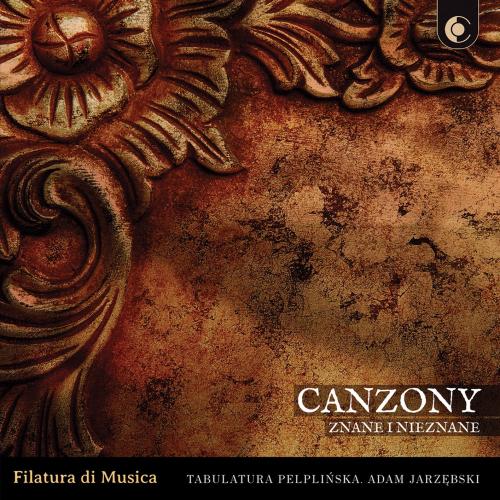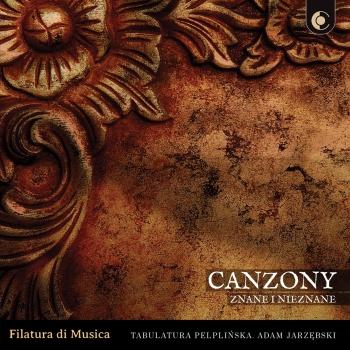
Canzony znane i nieznane Filatura di Musica
Album Info
Album Veröffentlichung:
2020
HRA-Veröffentlichung:
07.02.2020
Das Album enthält Albumcover
- Cesare Borgo (1550 - 1602):
- 1 The Pelplin Tablature: Canzona No. 2 "La castelnovata" 02:26
- 2 The Pelplin Tablature: Canzona No. 15 "L’averolda" 02:53
- Giovanni Valentini (1582 - 1649):
- 3 Canzoni, Book 1: Canzona à 4 in A Minor 02:30
- Adam Jarzębski (1590 - 1649):
- 4 Spandesa 02:26
- 5 Susanna videns 05:42
- Anonymous:
- 6 The Pelplin Tablature: Canzona No. 91 02:06
- 7 The Pelplin Tablature: Canzona No. 87 03:03
- 8 The Pelplin Tablature: Canzona No. 85 02:10
- Andrzej Rohaczewski (1590 - 1630):
- 9 Canzon à 4 in D Minor 02:49
- Adam Jarzębski:
- 10 Canzona prima 02:09
- 11 Canzona seconda 02:20
- 12 Canzona terza 03:09
- Thomas Morley (1557 - 1602):
- 13 The Pelplin Tablature: Canzona No. 74 03:04
- Anonymous:
- 14 The Pelplin Tablature: Canzona No. 84 02:26
- Tarquinio Merula:
- 15 La marcha, Op. 1 No. 7 01:58
- Adam Jarzębski:
- 16 Norimberga 06:17
- Anonymous:
- 17 The Pelplin Tablature: Canzona No. 89 02:20
- Adam Jarzębski:
- 18 Concerto primo 02:51
- Tarquinio Merula:
- 19 La lusignuola, Op. 1 No. 2 03:11
Info zu Canzony znane i nieznane
‘Filatura di Musica’ is an ensemble specializing in historically informed performance. It consists of musicians who graduated from prestigious art schools: Schola Cantorum Basiliensis, Koninklijk Conservatorium in the Hague, Staatliche Hochschule für Musik in Trossingen or Conservatoire de Musique in Grenoble. Artistic pursuits of the ensemble cover two areas of repertoire. The first is Renaissance and early Baroque music, performed in the typical of this period high pitch (a1= 465 Hz). The core instrumental ensemble is a consort, the varied body of which (recorders and traverso flutes, vielle/violin, violas da gamba) contributes to expressive demonstration of arabesque melodic lines of the 16th-century polyphony and concertante dialoguing in canzonas and sonatas from early 17th century. This is complemented with singing and the sound of keyboard instruments (virginal/positive organ).
Filatura di Musica:
Marek Nahajowski, recorders, artistic direction
Magdalena Pilch, recorders, transverse flute
Judyta Tupczyńska, violin
Patrycja Domagalska-Kałuża, chest organ
Justyna Młynarczyk, viola da gamba
Piotr Młynarczyk, viola da gamba
Marek Nahajowski
(b. 1979), music theorist, recorder-player performing on replicas of period instruments, lecturer in the Music Theory Faculty of the Grażyna and Kiejstut Bacewicz Academy of Music in Łódź, where he holds courses in the history and performance practice of Baroque music and since 2011 he has been conducting the recorder class. He is an author of the first Polish translation of Johann Joachim Quantz’s treatise Versuch einer Anweisung die Flöte traversiere zu spielen (O zasadach gry na flecie poprzecznym, Łódź 2012). His academic research focuses on hermeneutic interpretations of the 17th/18th-century musical pieces, as well as aesthetics and performance practice of Baroque and early Classicism. As an instrumentalist he has played with numerous early music ensembles, such as Il Tempo, Ars Cantus, Umbraculum, St Louis Club and others. Marek Nahajowski is also invited as a guest lecturer to early music interpretation courses like The Early Music Forum at the Frederic Chopin Music University, Polish Summer Early Music Workshops in Kalisz and Gorzów Meetings with Early Music.
Dieses Album enthält kein Booklet















